The Egyptian Meditation Room
When entering the room, one walks through a door splashed floor to ceiling with vibrant oranges, browns, and golds. Most prominently on this wall is a depiction of the famous weighing of the soul from the Egyptian Book of the Dead.
The Egyptian Meditation Room is located in the west wing of Ruscombe Mansion Community Health Center. It is a 238 sq. ft. room in the center of the house with south-facing windows and a fireplace. Around the room are replicas of artifacts from ancient Egypt as well as a collection of murals created by Baltimore artist, author, and radio host Robert “Dr. Bob” Hieronimus, Ph.D.
To reserve the Egyptian Meditation Room, call (410) 367-7300 or email wellness@ruscombe.org
Purpose of the Room
Dr. Bob Hieronimus dedicated the room to the 18th Dynasty Pharaoh Akhenaten, who introduced what some might describe as monotheism to ancient Egypt. All of the art inside the Egyptian Meditation Room connects to the vision of the oneness of humanity and oneness with the Creator. Since his early days, Hieronimus has championed the idea of “one planet, one people,” and found the story of Akhenaten’s religious transformation to have deep resonance. This room can be used to amplify the energy of any spiritual practices with the intention of connecting to the oneness of humanity. For decades it has been used by Ruscombe visitors as a space to pause and practice meditation. Today, it is open to anyone curious about ancient Egypt or in need of a space to reflect.
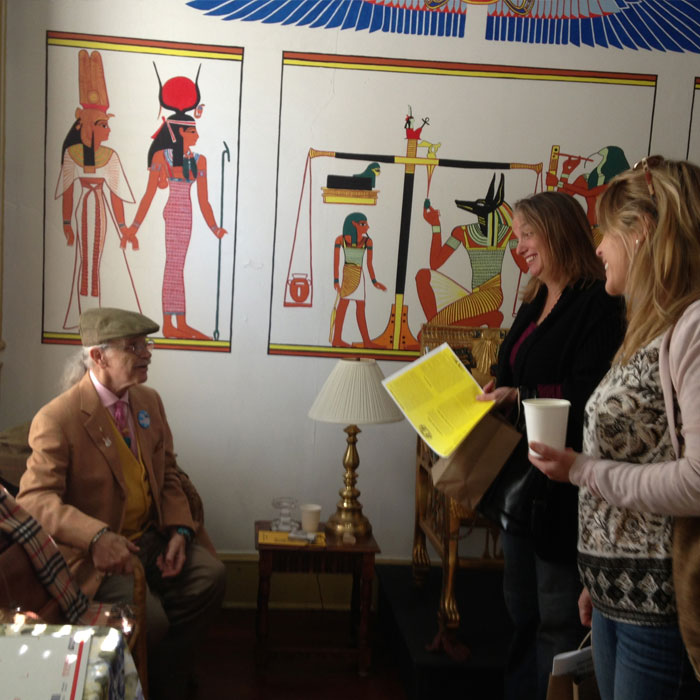
Creating The Egyptian Meditation Room
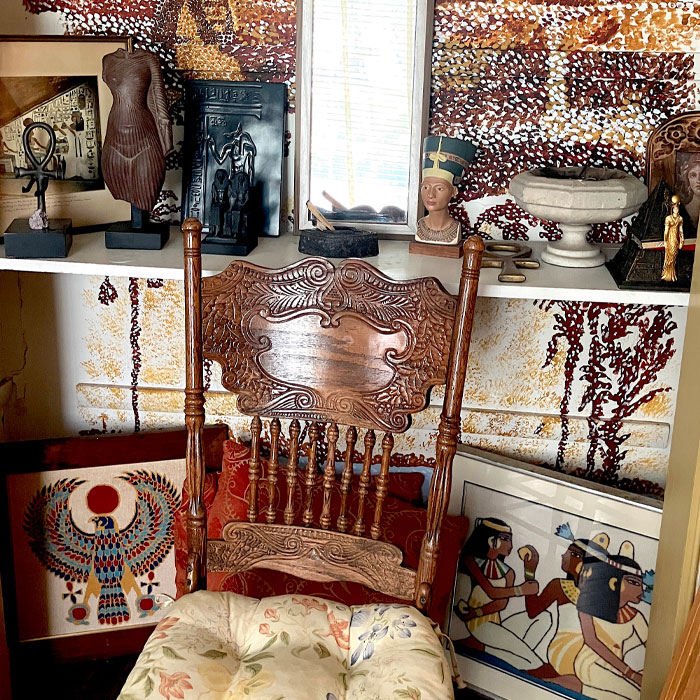
Dr. Bob led the artistic vision and completion of the Meditation Room and, with the help of Jennifer Gibbs, completed the space in five years. Mari Haskins Milholland provided funding, guidance, and artifacts to complete the room. A student and teacher of Egyptology, Mrs. Milholland was critically important to the process. She passed away in 1981 and her ashes were scattered in the Nile River in Thebes, Egypt. She was a true believer in the oneness of humanity and an instrumental patron, teacher and friend to Dr. Bob. Photos of her are on the mantle above the fireplace in the Meditation Room.
Hieronimus was was a leader in the early days of Ruscombe, before it became a health center. He founded Savitria, an esoteric commune that grew from a meditation study group formed by regulars of Charles Street’s Aquarian Age Bookstore. In its early days, the Meditation Room was Savitria’s chosen location for monthly moon rituals. This was around the same time that Hieronimus co-established the state-accredited AUM Esoteric Study Center. The purpose of AUM (formerly the Aquarian University of Maryland) is to unite the inner and outer aspects of one’s being and support altruistic endeavors that bring together all people on planet Earth. The Egyptian Meditation Room is an outgrowth of the communal, exploratory energy of Savitria and AUM’s philosophy.
Key Art and Artifacts
The Aten
The Aten was the singular deity that Akhenaten upheld as the Creator during his 17 years of rule – a drastic break from the deeply embedded Egyptian pantheon of many gods and goddesses. Scholars agree that the Aten is present in earlier writings about the gods but as only one aspect of the sun god. Influenced by his father Amenhotep III – a pacifist who seemed to prioritize the importance of the Aten amongst the gods – Akhenaten elevated the Aten to previously unseen heights. In the early years of his reign, he changed his name to reflect allegiance to the Aten aned forbade worship of all other gods.
This rapid evolution in religious practice affected more than just worship in ancient Egypt. The turn to Atenism invoked a new, more expressionist and androgynous style of art with a slightly more realistic and emotionally-centered depiction of people than eras past. It also required a new architectural style. In the capital city that Akhenaten ordered built in his 5th year of reign, religious structures were open-air and without ceilings. The purpose was to receive the full impact of the Aten’s life-giving rays and more effectively display the royal family. The family was seen as the medium through which the Aten communicated to the people and therefore their own worship of the Aten needed to remain as visible as possible.
The sun-disk represents the Aten, with rays extending down to Earth and ending in human hands. The Aten is also featured above the fireplace where a portrait of Akhenaten sits.
Worship of the Aten was about the sun, yes, but more precisely the focus was often on the light or warmth from the sun. This was the energetic connection between all Life and the Creator. This theme of light as healing and connecting energy appears in other esoteric traditions and, naturally, in much of Hieronimus’s artwork.
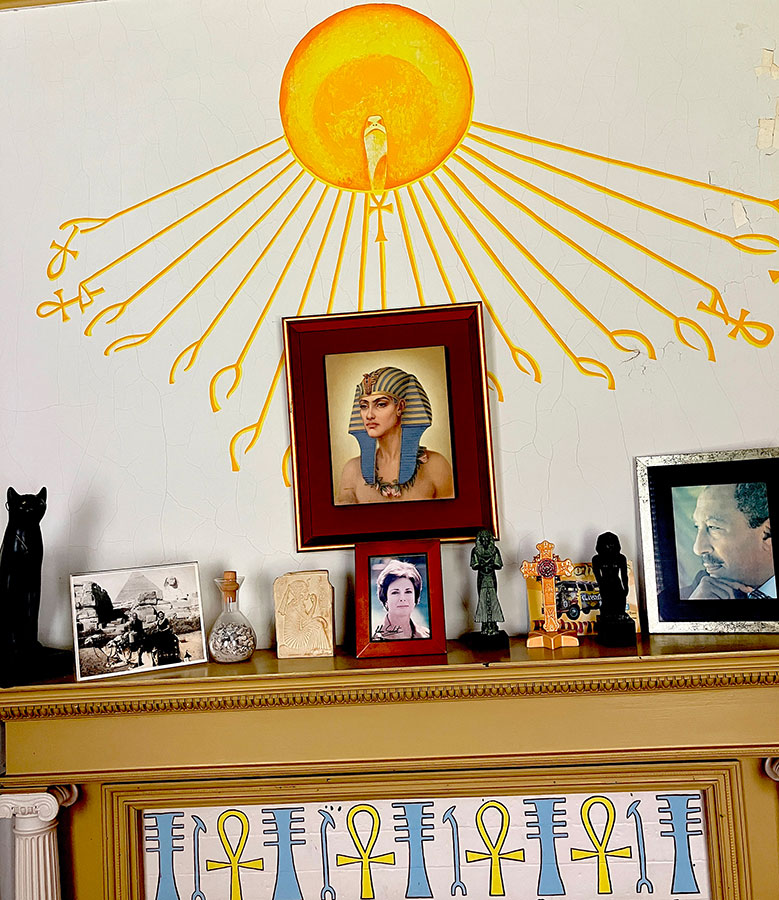
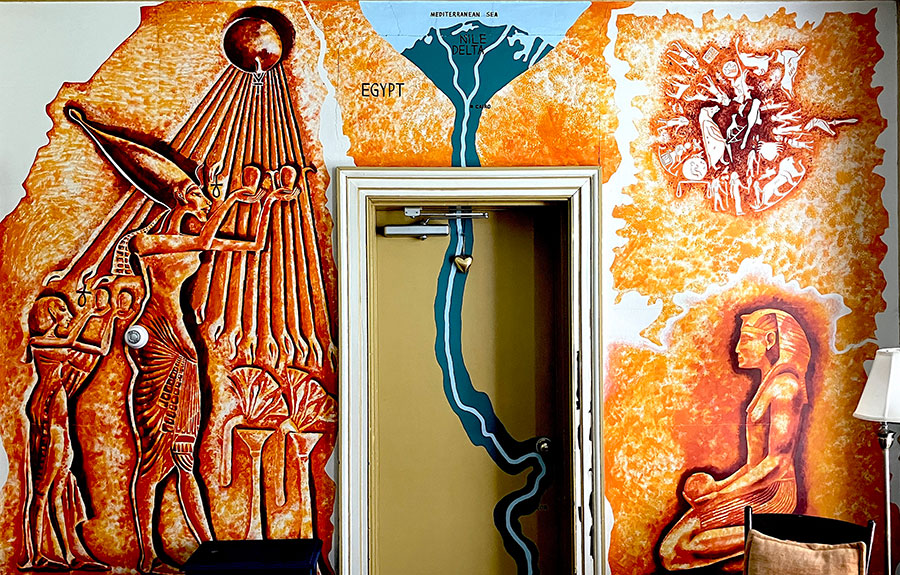
The remainder of the mural around the entrance door features a map of ancient Egypt with the Nile River running through it. Next to the Nile is a painting of the Denderah Zodiac, an ancient sandstone bas-relief that was carved into the ceiling of a chapel dedicated to Osiris in the Dendera Temple complex. [There is a close up of this: Dendereh Zodiac.jpg]It is one of the best-preserved ancient depictions of the observable stars. It depicts the five planets visible to ancient Egyptians in an alignment occurring once every thousand years as well as a solar and lunar eclipse.
Beneath is the kneeling figure of Thutmose III. He is sometimes referred to as the Napoleon of Egypt. Thutmose III began his reign in time to still the advance of Egypt’s enemies and made the nation into a world power. He is known for his military prowess as well as for his ability as a hunter. He is also honored for organizing the mystery schools of the 18th Dynasty into a single order.
In several images around the room, the heart plays a central role. In ancient Egypt, the heart was removed at death and placed in a separate jar (called the AB), bearing the hieroglyph for “Heart.” The ancient Egyptians believed the center of integrity was the heart, not the brain (“as a man thinketh in his heart…”), and that God recognized what was in a person’s heart. Thutmose III holds the AB in this depiction, offering his heart to God.
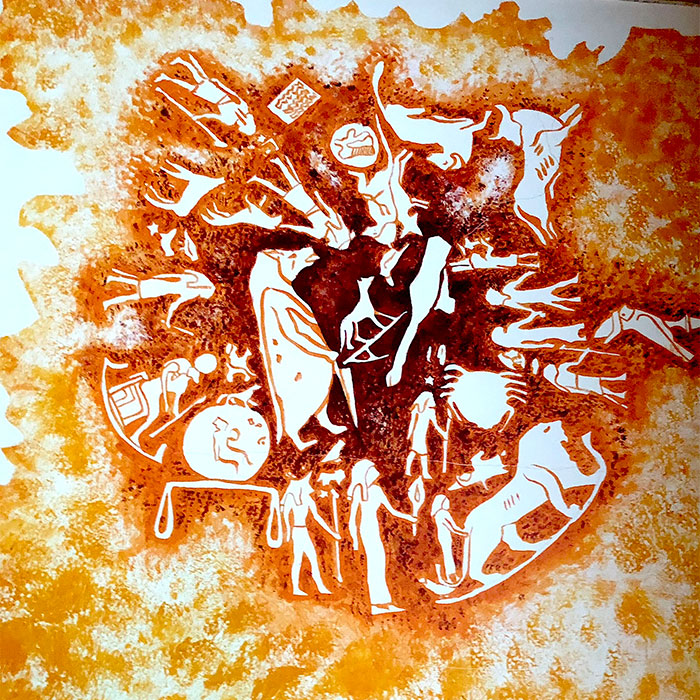
Akhenaten’s attempt at revolutionizing Egypt’s worship traditions were remarkable, but not necessarily welcome, especially by the elite. Decreed a heretic by the old Priesthood of Thebes and betrayed by his trusted general Horemheb, Akhenaten’s death was hasty and surreptitious with the clear intention of invalidating his vision and cutting his legacy short. The city he had built dedicated to the Aten (current day Tel el-Amarna) was destroyed, and all traces of his reign suppressed within a generation, on the orders of Horemheb.
It wasn’t until the late 1800s when archaeologists discovered the remains of Armana and, not long after, the tomb of the Pharaoh. The Egyptian Meditation Room also contains a replica of the famous bust of Queen Nefertiti, found originally in 1912.
To the right and left of the Sun Disk are two vultures. In Egypt, the vulture was the symbol of Nekhbet, the protecting goddess of birth, children, and pharaohs and queens. Nekhebet had a cult center of her own on the right bank of the Nile at the city of Nekheb and remained the protective Goddess of Upper Egypt throughout the country’s long history. The vulture symbolizes the transmitting power of wisdom, whereby the personality of the lower natures is consumed. She holds in her talons the ankh, a symbol of the very essence of life.
The Throne Chair
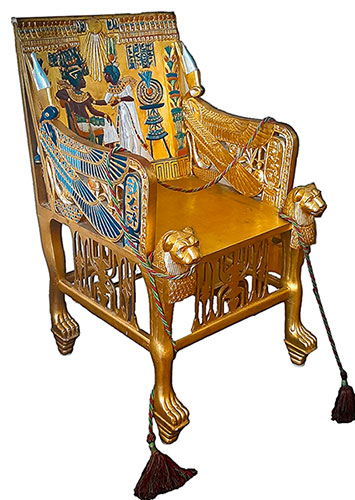
The most striking piece in the Meditation Room is a full-scale replica of the golden throne chair of Tutankhamun. This one was hand-carved in Cairo by one of the art guilds; the original has never left Egypt.
The back of the golden throne chair is significant among his treasures in two ways.
First, it presents the sensitive, emotional realism of the art that developed under the influence of Akhenaten, whom many Egyptologists believe was Tutankhamun’s father. On the throne chair, Tutankhamun and wife Ankhsenamun are portrayed in natural, relaxed forms, perhaps indicating the loving attitude of the entire family line.
Secondly, the throne chair of gold importantly shows the symbol of the Aten extending hands of benevolence to all people. The royal cartouche on the arms bear his earlier name Tutankaten. In the 5th year of his reign, he changed his name to Tutankhamun to appease the Priests of Amun at Thebes and distance himself from the -Aten family. The cartouche and depiction of the Aten call into question this supposed loyalty to the Priesthood and indicate Tutankhamun’s faithful connection to the Universal God Aten.
The winged cobras serving as arms for the throne chair symbolize the goddess Wadjet, the fierce protector of the pharaoh and armies of Egypt. The lion’s head and paws signify kingship, and the interweaving of the papyrus and lotus blossoms in the bottom of the chair are emblematic of the uniting of Upper and Lower Egypt into one nation.
Weighing of the Souls
On the wall behind the Throne Chair is a scene taken from the Egyptian Book of the Dead, believed by some to be an important ritual in initiating the aspirant to higher states of consciousness.
The heart is balanced on the pans of the scales against the Feather of Truth. Thoth, the god of writing, wisdom, and magic, records the verdict for the Akashic record, while Anubis, the jackal-headed Guardian of the Dead, (also depicted on the window blinds) attends the ritual.
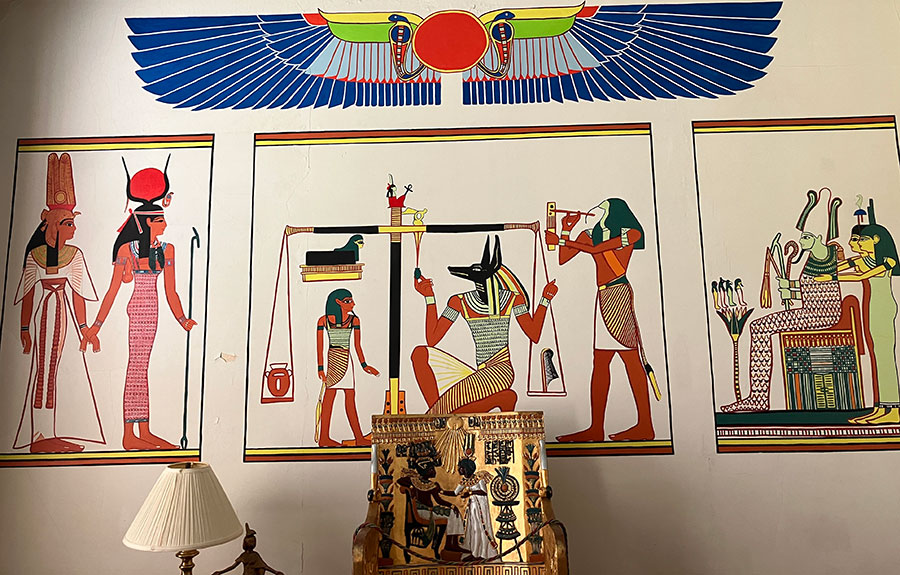
The panel to the left depicts Isis, goddess of healing and magic, leading the beloved Queen Nefertari to the Scales. Upon the head of Isis is a crown composed of a sun disk cradled by the horns of a cow, from which is attached a cobra. She wears a rolled chain on her breast, and an amulet is seen between her arm and back. In her left hand is the was scepter. Queen Nefertari is appropriately dressed for this afterlife ritual and wears over the vulture hood the tall, feathered crown of the Divine Consort.
Following the Weighing of the Souls we find Osiris as King and Judge of the Dead, sitting upon a funeral chest. Upon his head is the ATEF Crown, and he holds his usual emblems, the scepter, flail, and shepherd’s crook. Around his neck is the Menat, a protective amulet against evil spirits in the afterlife.
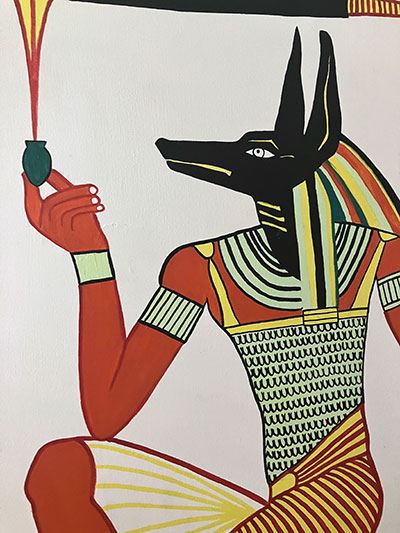

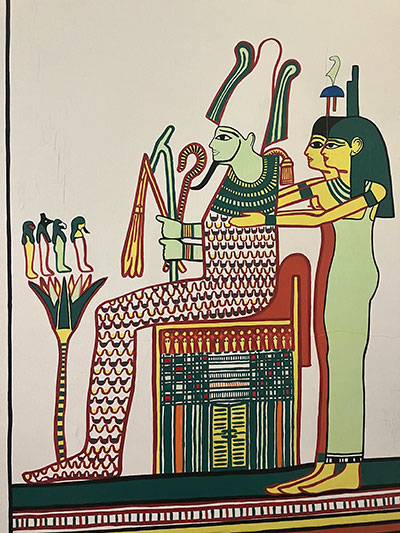
Click here to download a complete brochure to read more symbolic interpretations of the art and history in the Egyptian Meditation Room at the Ruscombe Mansion.